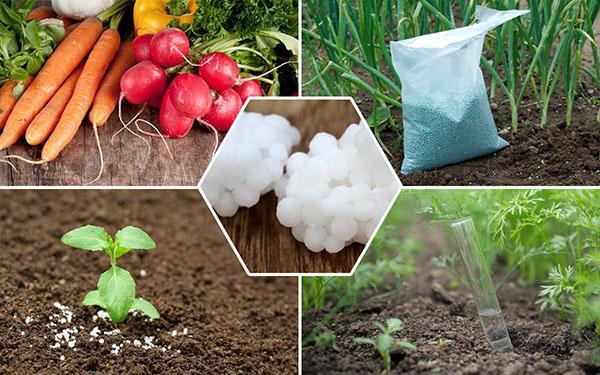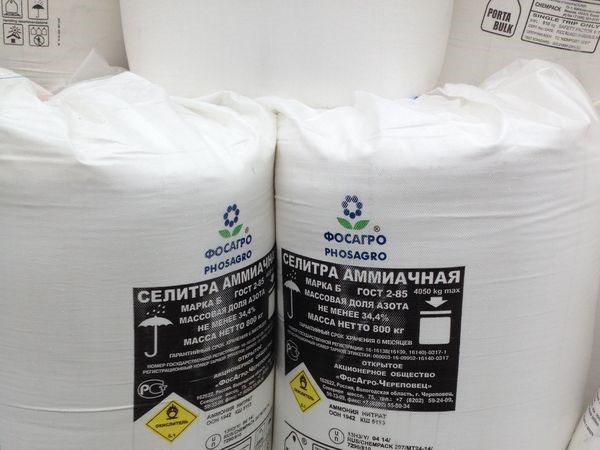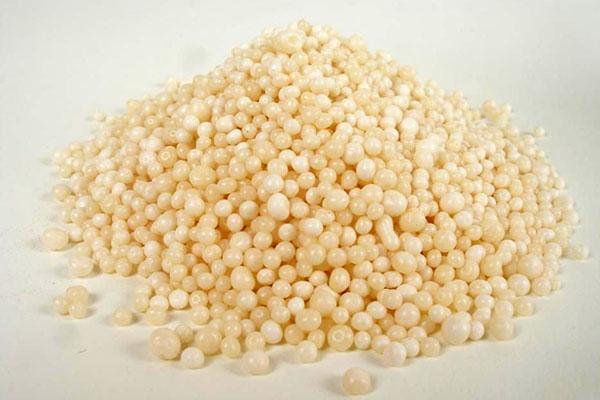Effective use of ammonium nitrate at their summer cottage
 The use of ammonium nitrate in agriculture is due to the long-term availability of nitrogen, which is especially important for plants with a long growing season. The chemical component is responsible for the production of chlorophyll and plant protein, without which plant development is impossible. Top dressing with ammonium nitrate guarantees healthy shoot growth, promotes long flowering and, accordingly, a high yield.
The use of ammonium nitrate in agriculture is due to the long-term availability of nitrogen, which is especially important for plants with a long growing season. The chemical component is responsible for the production of chlorophyll and plant protein, without which plant development is impossible. Top dressing with ammonium nitrate guarantees healthy shoot growth, promotes long flowering and, accordingly, a high yield.
What is ammonium nitrate made of?

Properties of ammonium nitrate

Moderate use of ammonium nitrate for plants gives good results due to its properties:
- Stimulates the growth and rapid development of plants.
- Increases crop resistance to various negative factors.
- Protects against possible bacterial diseases.
- Fruits grown using ammonium nitrate are subsequently stored for much longer.
- The fruiting of crops increases.
- Does not affect the quality of the crop.
- The fertilizer is completely soluble in water, and when irrigated, it saturates the soil with useful microelements.
The disadvantages of ammonium nitrate include acidity. In acidic soils, there is a significant decrease in yield.
You can neutralize the pH of the soil with lime and dolomite, which are taken in equal proportions.
Varieties of ammonium nitrate

If nitrate is used as fertilizer, then the composition may vary. There are several types:
- Simple ammonium nitrate - designed to supply agricultural crops with nitrogen. Serves as a complete replacement urea.
- Potassium - the composition also contains potassium. This top dressing is added during the flowering period and fruit ovary. Improves the taste characteristics of fruits.
- Calcium - used to saturate the soil with calcium. With a lack of this substance, vegetable crops develop slowly, the roots rot, the stems stop growing.
- Magnesium is an additional source of magnesium.
- Sodium is a type of potassium nitrate. Ideal for potatoes and beets.
- Calcareous includes potassium, calcium, magnesium. It is produced in the form of durable granules, easy to store and transport. If the particles are treated with fuel oil, there is no risk of increasing soil acidity.
- Grade B is a common type of nitrate for fertilizing seedlings and houseplants.
Chemical formula of simple ammonium nitrate NH4NO3.
Basic conditions for the use of ammonium nitrate
 A highly effective fertilizer is chosen taking into account the composition of the soil, the climatic characteristics of the region, the type of plants, and its own agrochemical capabilities.
A highly effective fertilizer is chosen taking into account the composition of the soil, the climatic characteristics of the region, the type of plants, and its own agrochemical capabilities.
A universal product suitable for almost all types of soil. In sandy soils, the composition will not change under the influence of nitrate. When applied in podzolic soils, the acidification effect can be observed. In clay, heavy soils, fertilizer is applied in the autumn-spring period.
Ammonium nitrate is widely used in gardening. She is fed fruit trees, berry bushes. Fertilize the soil with a nitrogenous substance when planting grain, vegetable crops, and also stimulate the growth of weakly growing flowers, decorative deciduous indoor plants.
It has been scientifically proven that the use of ammonium nitrate as a top dressing increases crop yields by 40-50%.
Rates and terms for the introduction of ammonium nitrate
 The nitrogenous preparation is introduced into the ground in dry and dissolved form. Each top dressing is accompanied by abundant watering. If the soil is depleted, then the rate per 1 sq. m is 40-50 g of dry matter. In cultivated soil, the amount of fertilizer is reduced to 30 g per 1 sq. m:
The nitrogenous preparation is introduced into the ground in dry and dissolved form. Each top dressing is accompanied by abundant watering. If the soil is depleted, then the rate per 1 sq. m is 40-50 g of dry matter. In cultivated soil, the amount of fertilizer is reduced to 30 g per 1 sq. m:
- For seedlings. The dry fertilizer rate is 5–6 g per well when planting. During cultivation, they are fed with an aqueous solution of ammonium nitrate. For 10 liters of water you need 35-40 g.
- For vegetable crops. Average dosage is 20 g per 1 sq. m. During the initial cultivation of the soil, the rate can be increased. During the period of active growth, you need 20-30 g of nitrate and 10 liters of water.
- For garden trees and shrubs. A solution of 10 liters of water with 30 g of fertilizer dissolved in it is poured under the trunk. Nitrogen fertilization promotes the emergence of new shoots.
For foliar top dressing, ammonium nitrate is not suitable, since you can burn the leaves.
As for the timing of the introduction of ammonium nitrate - it is preferable to fertilize crops in the spring, at the beginning of the growing season and before flowering. In the second half of summer, it is not advised to use nitrogen-containing dressings. This provokes the growth of shoots to the detriment of the formation of fruits. Vegetables should be fed twice before flowering and after fruit formation. Garden trees are fed once, after the first leaves appear.
The use of ammonium nitrate in floriculture
 Nitrogen fertilizer is often used in flower cultivation. Since they react to this with lush and long flowering. For example, during planting or transplanting of petunias, gloxinias or other flowers, add 1 tbsp. l. nitrate per 10 liters of substrate. Or watering is carried out with an aqueous solution of fertilizer.
Nitrogen fertilizer is often used in flower cultivation. Since they react to this with lush and long flowering. For example, during planting or transplanting of petunias, gloxinias or other flowers, add 1 tbsp. l. nitrate per 10 liters of substrate. Or watering is carried out with an aqueous solution of fertilizer.
Ammonium nitrate is also used for indoor decorative leafy plants. Thanks to nitrogen, the leaves of palm trees, ficuses become larger, acquire a juicy green tint.
Disadvantages of nitrate
 Gardeners need to know that, in addition to the undeniable benefits, ammonium nitrate can be harmful. A few years ago, this nitrogen fertilizer was banned. The reason is the explosiveness of the chemical compound. Now its popularity has grown due to its wide range of applications and low cost. However, basic safety precautions must be followed when handling this substance.
Gardeners need to know that, in addition to the undeniable benefits, ammonium nitrate can be harmful. A few years ago, this nitrogen fertilizer was banned. The reason is the explosiveness of the chemical compound. Now its popularity has grown due to its wide range of applications and low cost. However, basic safety precautions must be followed when handling this substance.
- The chemical characteristics of ammonium nitrate do not allow storing it together with sawdust, peat, lime, and straw. Since spontaneous combustion is possible.
- Do not allow nitrogen solution to come into contact with green shoots of plants.
- It is impossible to exceed the indicated dosages of the drug.
- It is not advisable to feed cucumbers, squash, zucchini with saltpeter. They tend to accumulate nitrates, which are harmful to humans.
- Observe safety precautions during storage and transportation.
- Do not leave open containers with fertilizers, nitrogen will escape.
- Avoid overheating.
- Store in a dark, cool place at an air temperature not exceeding + 30 ° С.
 There are a lot of areas where ammonium nitrate is used, but it is most in demand in agriculture. The utilization rate is 80%. Saltpeter occupies more than half of the fertilizer market, and the demand for it is increasing every year.
There are a lot of areas where ammonium nitrate is used, but it is most in demand in agriculture. The utilization rate is 80%. Saltpeter occupies more than half of the fertilizer market, and the demand for it is increasing every year.